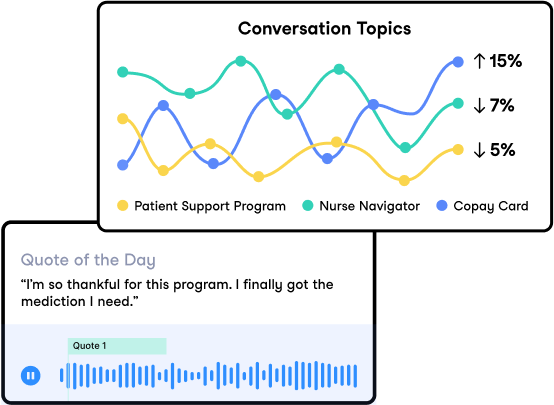Your patients are talking. Are you listening?
Healthcare is complex (and confusing your customers). Conversational analytics listens to customer interactions already happening and offers actionable insights.
Learn More
Learn how AI is unlocking insights across healthcare as we debunk 5 common myths around this emerging tech.

Patient experience in healthcare is changing.
Is your strategy to adapt working? You wouldn’t go to a doctor that couldn’t offer a diagnosis. The same rule applies to the data tools being leveraged to monitor customer experience.
View Case StudyOver 50,000 patient interactions demonstrate how pervasive disruptions in the healthcare patient journey continue to be.
Patient Satisfaction Surveys
Patient satisfaction surveys are important for healthcare providers to inform approaches to care geared towards patient needs. With the right patient satisfaction survey tools, providers can better understand patient concerns and offer the best possible level of care both actively and proactively. Patient satisfaction surveys are an effective tool for understanding patient concerns and struggles and the importance of patient satisfaction surveys cannot be overstated.
Patient satisfaction survey examples include after visit calls, online outreach after televisits, and other forms of post-care outreach. Patient satisfaction survey in healthcare help providers understand the experiences and concerns of patients so that they can better inform care methods and practices moving forward. With the proper tools, providers can better understand surveys and use a data driven approach to utilizing the vital information they can gather using patient satisfaction surveys.
Using Authenticx, you can not only analyze patient satisfaction surveys, gleaning important information that patients wish to share, but you can also analyze satisfaction of patients using feedback from customers on phone calls. These tools can enable you to better understand what drives patient and customer satisfaction, what barriers are currently causing turmoil for customers and patients, and how you can better inform future care to address these barriers. This can be vitally important for healthcare providers, as patient satisfaction surveys and customer feedback on calls can be vastly overlooked as a tool for enabling the best possible care and experiences for patients.
Patients are often very willing to share their grievances and components of care that they appreciate and this can be crucial information for informing care and practices, but if it’s overlooked, important details and data can slip through the cracks. By understanding this data, you can instead ensure that care involves the best practices for driving patient satisfaction and comfort.
How To Measure Patient Satisfaction
Understanding what drives or doesn’t drive patient satisfaction isn’t simply a matter of enabling patients to leave feedback. It’s also important to understand what the data means and analyze it effectively to further improve care and practices. With Authenticx, healthcare providers can better understand the data they’re presented with after receiving feedback in the form of calls and surveys, so that they can best use this crucial data to inform care and practices.
How to measure patients satisfaction goes beyond simply asking the questions, it also involves understanding the answers and analyzing how patients might respond via either survey or phone call.
With Authenticx, healthcare providers get the tools to measure patient satisfaction and can use targeted call evaluations to glean important pieces of data that patients leave in their calls and use that data to inform optimal practices moving forward. Using data based storytelling, Authenticx enables providers to perform valuable patient satisfaction research that goes beyond just simple metrics and instead informs providers about crucial points of data that inform deeply about how patients are feeling.
Questionnaire on Patient Satisfaction In A Hospital
In hospitals, understanding the factors behind patient satisfaction is not only crucial for best operating, but also can be difficult to sort through.
With a high volume of patients and lots of feedback being left, it can be a difficult task to sort through all of it, identify patterns, and determine which trends and individual obstacles are helping or hindering patients’ satisfaction each day. In all departments, patient satisfaction feedback is important to understand but can be difficult to make the most out of, especially manually.
Whether inpatient or outpatient, patient satisfaction is an important factor that drives how hospitals operate. It’s often important to produce a questionnaire for patient satisfaction in OPDs, just as it is to have useful inpatient questionnaires, and in both cases, it’s important to understand the data that’s being left by patients in these documents.
Understanding a questionnaire on patient satisfaction in a hospital is just as important as having a questionnaire in the first place, and using Authenticx to glean important data is one of the best ways that care providers can increase their quality of care and best operate to improve patient satisfaction over time.
As important as a patient satisfaction survey questionnaire in a hospital is, understanding the information that patients leave in phone calls and how that can inform best care practices is equally if not more important, since patients can leave more detailed and nuanced information, as long as care providers have the tools to analyze this information, and with Authenticx, care providers can do both efficiently.
How It Works
Gain a deeper level understanding of contact center conversations with AI solutions.
See a PreviewAggregate
Pull customer interaction data across vendors, products, and services into a single source of truth.
Analyze
Collect quantitative and qualitative information to understand patterns and uncover opportunities.

Activate
Confidently take action with insights that close the gap between your organization and your customers.
Types of Patient Satisfaction Surveys
Patient satisfaction surveys are numerous and varied in their approach. There are many different types of patient satisfaction surveys, and though they generally aim to understand the same thing, there are some different approaches to gaining the right feedback to inform care and practices.
Some surveys will simply include patient experience survey questions and assume that these questions are effective and gleaning information while some care providers may prefer to use rigorously tested and validated patient satisfaction survey methods. In each case, patient experience questionnaires are a good place to begin looking into the obstacles in patient satisfaction, but there are also more in depth approaches to understanding patient care satisfaction.
One of the most effective and often overlooked methods is analyzing patient phone calls to determine how patients are feeling about care and possible obstacles for them in their care experience. During phone calls with your organization, patients are already aware that their call is being recorded or monitored, but they’re also quite likely to share invaluable information about their experience.
Phone calls are inherently more open-ended than satisfaction surveys and allow patients to address issues that aren’t necessarily present or asked about inpatient feedback surveys and questionnaires.
They can share in as much or little detail as they’re comfortable about their experience and they can exercise expression with much more nuance and in-depth discussion. These phone calls can be a vast wealth of vital information that can help care providers inform their future care to best meet the needs of patients, but they often go overlooked as a method for making these types of determinations.
By using Authenticx, care providers can tap into this vast wealth of valuable data and better understand the factors that are driving patient satisfaction and dissatisfaction with care.
Patient Satisfaction Project
Compiling patient satisfaction information can seem like an uphill task, but to identify points where common practices can be improved and understand overall trends in patient satisfaction, compiling a project that takes a comprehensive overview look at accumulated patient satisfaction data can help healthcare providers inform the best next steps to take to improve overall patient satisfaction inpatient experiences.
Finding ways to bring together patient satisfaction survey results and make informed determinations about what the data means is important overall, and having a successful patient satisfaction project can help a healthcare organization overall. Especially for a large organization that’s national patient satisfaction survey results can be simultaneously crucial and difficult to track for the big picture.
With Authenticx, even very large healthcare providers can effectively structure their patient satisfaction survey reports and get a big picture look without manually sifting through tons of data.
Authentic gives healthcare providers the tools they need to tag survey results and figure out what is driving and hindering patient satisfaction in the big picture, easily. The data can be easily organized, understood, and even shared across their organization so that the right information can make it into the right hands, and the right steps can be taken to improve overall practices to drive patient satisfaction overall.
Patient Satisfaction Survey Template
Developing the right patient satisfaction surveys can be a big task. It’s important to know which questions to ask, to whom, and in what format to most effectively get the data healthcare providers to need to improve their practices to drive increased patient satisfaction. Patient satisfaction survey questions must get at the heart of potential concerns and give patients the opportunity to answer the right questions to better inform care in the future.
Developing a patient satisfaction survey template can be an important first step in developing individual patient satisfaction survey questionnaires for different departments within an organization. A questionnaire for patient satisfaction in OPD might look different than that of inpatient departments, but it can be helpful to have a template that informs the framework of both respectively, in order to keep data well organized and relevant across the board.
Developing common hospital patient satisfaction survey questions is an important step for large organizations that will have a lot of data to go through to best inform future care practices. Using Authenticx, though, healthcare providers can easily organize and analyze and understand data that comes in from patient feedback and improve care practices using that information.